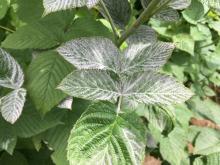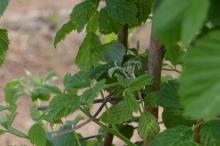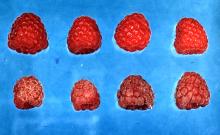See:
Raspberry Cultivar Susceptibility
Cause Podosphaera macularis (formerly Sphaerotheca macularis), a fungus. Powdery mildew is occasionally a serious disease on foliage, new canes, and fruit of red raspberry in the Pacific Northwest. It also can infect 'Loganberry' leaves. The fungus overwinters as mycelium in dormant buds of stunted cane tips or as chasmothecia. Optimum conditions for spore germination and infection are 65°F to 80°F with relative humidity of 97% to 99%. In May, leaves develop lesions that produce fungal spores that are blown to healthy foliage. In June small, secondary-infection lesions appear on vegetative tissue and developing fruit.
Powdery mildew also attacks 'Munger' black raspberry, 'Himalaya', and some other blackberries. The 'Puyallup' red raspberry is very susceptible, so powdery mildew may be a limiting factor with that cultivar. 'Canby', 'Fairview', 'Haida", 'Skeena', 'Wakefield', and 'Washington' are sometimes infected. 'Amity', 'Cascade Bounty', 'Chilcotin', 'Heritage, 'Rudi, 'Sumner', and 'Willamette' are resistant. The powdery mildew of raspberry does not infect strawberry and that of strawberry does not infect raspberry despite the similar name.
Symptoms A whitish-gray powdery coat covers foliage, young growing tips of canes, and fruit. The first lesions on infected leaves are generally on the lower-leaf surface causing light green blotches on the upper surface. Infected shoot tips may be covered with mycelial growth. Severe mildew retards, dwarfs, and distorts plant parts. Infected fruit may become covered with a white, mealy mat of fungus. Severely infected berries fail to size properly and wither and die.
Cultural control
- Do not plant close to wooded areas that might shade the field.
- Plant more-resistant cultivars.
- Remove any infected primocanes that occur late in the season.
- Create an open plant canopy to improve air circulation and increase light penetration.
Chemical control
- Apply dormant or delayed-dormant lime sulfur. Sprays may burn foliage in warm weather.
- Rex lime sulfur (28%) at 6 to 12 gal/100 gal water. 48-hr reentry. O
- Sulforix at 3 gal/100 gal water. 48-hr reentry.
- Spray first when first blossoms open, then regularly until all fruit is set. Interval will depend on products used such as 7 to 10 days for sulfur or 14 days for Group 3 or 11 fungicides. Alternate or tank-mix products from different groups that have different modes of action. Limit the use of any one group during crop production. Selection of products for rotation and/or mixing must consider group 7 fungicides when used through the irrigation as a nematicide.
- Abound at 6 to 15.5fl oz/A. Do not apply with silicone-based surfactants. May be applied on the day of harvest. Group 11 fungicide. 4-hr reentry.
- Cabrio EG at 14 oz/A. May be used at harvest. Overuse of this material will lead to resistant fungi, so alternate with other materials. Group 11 fungicide. 12-hr reentry.
- Cinnerate at 16 to 64 fl oz/100 gal water plus an adjuvant. 4-hr reentry. O
- EcoSwing at 1.5 to 2 pints/A. Can be used day of harvest. Group BM01 fungicide. 4-hr reentry. O
- Flowable sulfur (52%) at 2.5 gal/A. Group M2 fungicide. 24-hr reentry. O
- JMS Stylet Oil at 3 to 6 quarts/100 gal water. Do not use with or near a sulfur application. Do not use during freezing temperatures, above 90°F, or when plants are under heat or moisture stress. Do not use when foliage is wet because good coverage is essential. 4-hr reentry. O
- Kaligreen (82% potassium bicarbonate) at 2.5 to 3 lb/A. Might supplement a normal program when powdery mildew is first observed. Do not mix with other pesticides. Thorough coverage is essential. 4-hr reentry. O
- Luna Tranquility at 13.6 to 27 fl oz/A. May be used day of harvest. Group 7 + 9 fungicide. 12-hr reentry.
- Monterey Bi-Carb Old Fashioned Fungicide at 4 teaspoons/2 gal water. H
- Oso SC at 6.5 to 13 fl oz/A. May be applied on the day of harvest. Group 19 fungicide. 4-hr reentry. O
- Ph-D WDG at 6.2 oz/A plus an adjuvant. May be applied on the day of harvest. Group 19 fungicide. 4-hr reentry.
- Prev-Am at 50 fl oz/100 gal water. Do not use above 90°F or when plants are under heat or moisture stress. 24-hr reentry.
- Pristine at 18.5 to 23 oz/A. Can be used day of harvest. Group 7 + 11 fungicide. 12-hr reentry.
- Prolivo 300 SC at 4 to 5 fl oz/A. Can be used day of harvest. Group 50 fungicide. 4-hr reentry.
- Propiconazole-based fungicides are registered. Do not use within 30 days of harvest. Do not mix with insecticides during bloom due to bee toxicity. Group 3 fungicides.
- Bumper 41.8 EC at 6 fl oz/A. 12-hr reentry.
- PropiMax EC at 6 fl oz/A. 12-hr reentry.
- Tilt at 6 fl oz/A. 24-hr reentry.
- Quadris at 6 to 15.5 fl oz/A. Do not apply with silicone-based surfactants. May be applied on the day of harvest. Group 11 fungicide. 4-hr reentry.
- QuiltXcel at 14 to 21 fl oz/A. Do not use within 30 days of harvest. Sprayers should not be used on apples. Group 3 + 11 fungicide. 12-hr reentry.
- Rally 40 WSP at 1.25 to 2.5 oz/A. Applications may be made up to the day of harvest. Group 3 fungicide. 24-hr reentry.
- Regalia at 1 to 4 quarts/A. Use on 7-day intervals. May be used day of harvest. Does not benefit from the addition of an adjuvant. Group P5 fungicide. 4-hr reentry. O
- Sil-Matrix at 1 to 4 quarts/100 gal water plus a nonionic surfactant. Can be applied up to the day of harvest. 4-hr reentry. O
- Spectracide Immunox Multi-Purpose Fungicide Spray Concentrate for Gardens at 0.67 fl oz/gal water. May be applied up to the day of harvest. Group 3 fungicide. H
- SuffOil-X at 1 to 2 gal/100 gal water. Do not use in conjunction with sulfur or captan. Do not use when plants are under heat or moisture stress. Do not use when foliage is wet as good coverage is essential. 4-hr reentry.
- Sulfur-based products have good efficacy. Do not use within 2 weeks of an oil spray. Group M2 fungicides. 24-hr reentry. O
- Bonide Sulfur Plant Fungicide (90% wettable) at 2 to 2.5 Tbsp/gal water. H
- Microthiol Disperss (80% sulfur) at 6 to 15 lb/A. Do not use a spreader-sticker.
- Thiolux (80% sulfur) at 6 to 15 lb/A.
Biological control
- Aviv (Bacillus subtilis strain IAB/BS03) at 10 to 30 fl oz/100 gal water. Unknown efficacy. Preharvest interval not specified. 4-hr reentry. O
- LifeGard WG (Bacillus mycoides isolate J) at 4.5 oz/100 gal water. Does not have direct activity on pathogens but stimulates host defenses. Unknown efficacy. 4-hr reentry. O
- Serenade OPTI (Bacillus subtilis strain QST 713) at 14 to 20 oz /A. Active ingredient is a small protein. Pest not on label but legal to use and has activity on powdery mildews on other crops. 4-hr reentry. O
- Sonata (Bacillus pumilis strain QST 2808) at 2 to 4 quarts/A plus a surfactant. May be applied up to and including the day of harvest. 4-hr reentry. O
- Stargus (Bacillus amyloliquefaciens strain F727) at 1 to 4 qt/A plus a nonionic surfactant. May be used day of harvest. 4-hr reentry. O
- Theia (Bacillus subtilis strain AFS032321) at 1.5 to 5 lb/A. May be applied up to and including the day of harvest. 4-hr reentry. O
Reference Harvey, N. and Xu, X.M. 2010. Powdery mildew on raspberry is genetically different from strawberry powdery mildew. Journal of Plant Pathology 92:775-779.






